The expenses linked to lighting systems include initial purchases, installation, energy consumption, and maintenance. Examining these components offers valuable insights for boat owners aiming to optimize their budgets while ensuring efficient operations at sea.
The fishing industry, while often associated with the thrill of the catch and the serenity of open waters, entails a series of financial commitments, particularly concerning operational necessities. Among these, lighting plays an integral role. Fishing boat lighting encompasses various types, such as navigation lights, deck lights, and internal lighting, all of which contribute to safety, functionality, and efficiency. Understanding the expenses associated with these lighting systems is paramount for boat owners and operators to maintain operational efficiency and ensure safety at sea.
Reach out for free lighting consultation
Table of Contents
ToggleFishing boats operate under various conditions, including night fishing and adverse weather. Proper lighting not only facilitates visibility for the crew but also ensures compliance with maritime regulations. Different types of lighting are used for specific purposes: navigation lights for signaling the vessel’s position and direction, deck lights for illuminating working areas, and internal lights for crew comfort and safety.

Fishing boats generally utilize three primary types of lighting systems: navigation lights, deck lights, and interior lights. Each type serves a unique purpose and comes with its own set of costs.
Navigation lights are mandated by maritime law and are used to indicate a vessel’s presence and movements to other boats. The specific type and number of lights depend on the boat’s size and intended use. These lights must be visible from a distance and may include:
The costs associated with navigation lights include initial purchase, installation, maintenance, and potential upgrades to comply with evolving regulations.
Deck lights are vital for illuminating working areas on the fishing vessel. These lights are crucial during nighttime operations, ensuring that crew members can work safely and efficiently. The types of deck lights can include:
Expenses for deck lights involve the purchase price, installation labor, electricity consumption, and regular maintenance to ensure functionality over time.
Interior lights enhance the comfort and safety of the crew while onboard. These lights are used in living quarters, kitchens, and bathrooms, creating a livable environment during extended trips at sea. Interior lighting expenses encompass:
The investment in lighting systems is crucial not only for immediate operational needs but also for long-term durability and compliance with safety regulations.
When analyzing fishing boat lighting expenses, several core components contribute to the overall financial burden. Understanding these costs can help fishing boat owners budget effectively and explore potential areas for optimization.

The initial purchase costs represent the expenditure on acquiring lighting fixtures and equipment. These costs vary depending on the type of lighting and the specifications required for the vessel. For example, navigation lights often come in kits that can range from a few hundred to several thousand dollars, depending on the boat size and type. Deck and interior lighting costs also vary widely based on quality and functionality.
Installation costs are a significant part of the overall expenses associated with fishing boat lighting. Depending on the complexity of the lighting systems and the boat’s design, installation may require professional services. Labor costs can differ based on geographic location, technician experience, and the time required to complete the job. Some boat owners may opt for a DIY approach to minimize costs; however, this route carries the risk of improper installation, which can lead to safety issues and additional expenses down the line.
Over time, lighting systems may require maintenance and repair. Regular checks to ensure that navigation lights are functional can prevent accidents and legal issues at sea. Maintenance tasks may include bulb replacement, cleaning fixtures, and addressing wiring issues. The costs associated with these activities can accumulate, especially for vessels that operate frequently and under harsh conditions.
Energy consumption is an ongoing expense that boat owners must consider. The type of lighting chosen can significantly impact electricity costs, particularly for vessels that operate long hours at night. Traditional incandescent bulbs consume more power than LED alternatives, leading to higher operational expenses. Although LED lights typically have a higher initial purchase cost, their longevity and energy efficiency can result in lower overall expenses.
Compliance with maritime regulations often requires periodic upgrades to lighting systems. New regulations may mandate changes to navigation lights or require enhanced visibility features. Boat owners must be prepared for the financial implications of upgrading their lighting systems to maintain compliance and ensure the safety of their vessels.
Insurance is another component to consider when evaluating fishing boat lighting expenses. Proper lighting can influence insurance premiums, as vessels equipped with effective lighting systems may be viewed as lower-risk. Conversely, inadequate lighting could lead to higher premiums due to the increased likelihood of accidents. Understanding the interplay between lighting and insurance costs can help boat owners make informed decisions about their lighting systems.
The depreciation of lighting systems is a factor that should not be overlooked. As with any equipment, the value of lighting fixtures diminishes over time. Factors such as usage frequency, exposure to harsh weather conditions, and maintenance levels can impact the rate of depreciation. Boat owners should consider how depreciation affects their financial planning and budget for potential replacements or upgrades.
To illustrate the various components of fishing boat lighting expenses, the following table provides a detailed breakdown of estimated costs associated with each component. Please note that these figures are approximate and can vary based on specific circumstances, vessel types, and locations.
| Expense Component | Estimated Cost Range |
|---|---|
| Initial Purchase Costs | $300 – $3,000 |
| Installation Expenses | $200 – $1,500 |
| Maintenance and Repair Costs | $100 – $1,000 per year |
| Energy Consumption Costs | $20 – $200 per month |
| Compliance and Upgrading Costs | $100 – $2,000 per upgrade |
| Insurance Costs | $500 – $2,000 annually |
| Depreciation | 10-20% of initial cost yearly |
Effective management of fishing boat lighting expenses can lead to significant savings over time. Boat owners and operators can adopt various strategies to navigate and optimize these costs.

Opting for energy-efficient lighting options, such as LED lights, can significantly reduce energy consumption costs. While the initial investment may be higher, the long-term savings on electricity bills and maintenance expenses make this choice financially prudent. LEDs also offer extended lifespans, reducing the frequency of replacements.
Establishing a routine maintenance schedule for lighting systems can prevent costly repairs and ensure all lights remain functional. Regular checks of bulbs, wiring, and fixtures can identify potential issues before they escalate into significant problems. Many boat owners find that investing a small amount in maintenance can prevent much larger expenses in repairs and replacements.
Boat owners should stay informed about regulatory changes that could impact their lighting systems. By proactively budgeting for potential upgrades, owners can avoid the financial strain of last-minute compliance efforts. Maintaining an open line of communication with maritime regulatory bodies can help in understanding impending changes that may require adjustments to lighting setups.
Fishing boat owners may be eligible for tax deductions related to lighting expenses, particularly if the vessel is used for commercial purposes. Consulting with a tax professional can help identify potential deductions and financial strategies that align with lighting investments.
Utilizing technology to monitor energy consumption can lead to more informed decisions regarding lighting usage. Smart lighting systems can provide data on energy usage and performance, enabling boat owners to adjust their lighting strategies based on real-time feedback. This approach can help optimize energy consumption and reduce costs over time.
Fishing boat lighting expenses encompass a diverse array of costs, from initial purchase and installation to maintenance and energy consumption. By understanding these components, boat owners can develop a comprehensive approach to managing expenses effectively. Through strategic decision-making, adopting energy-efficient technologies, and maintaining compliance with regulations, fishing boat operators can ensure that their lighting systems contribute positively to their overall operational efficiency and safety on the water.